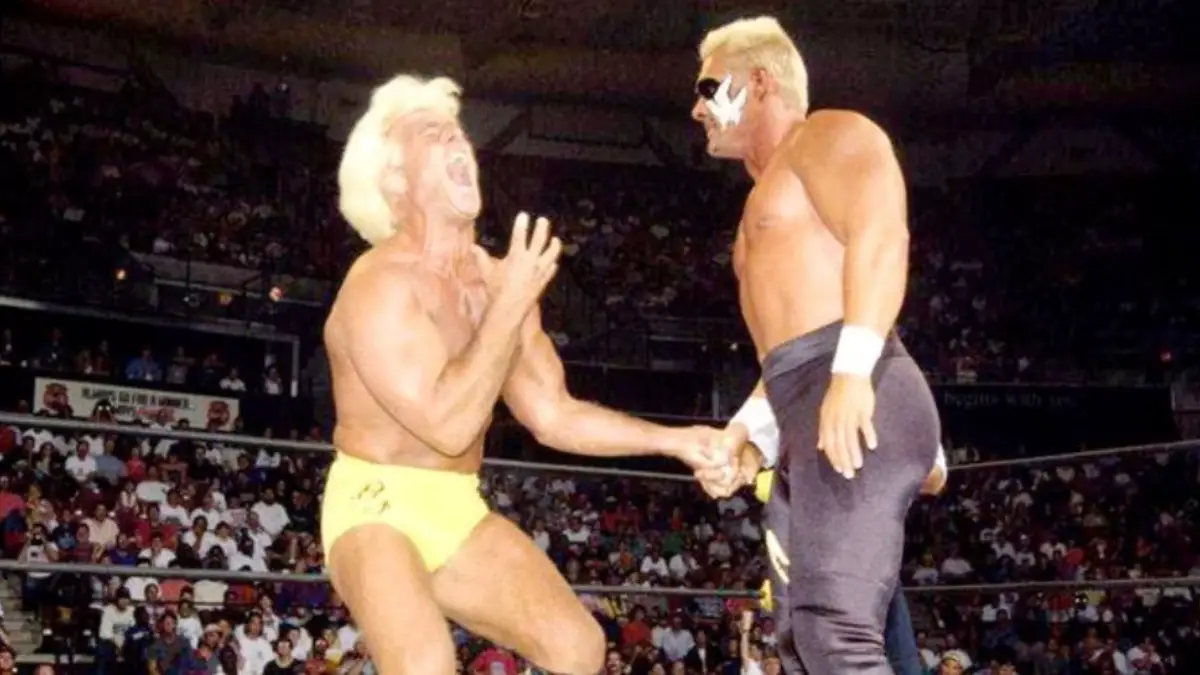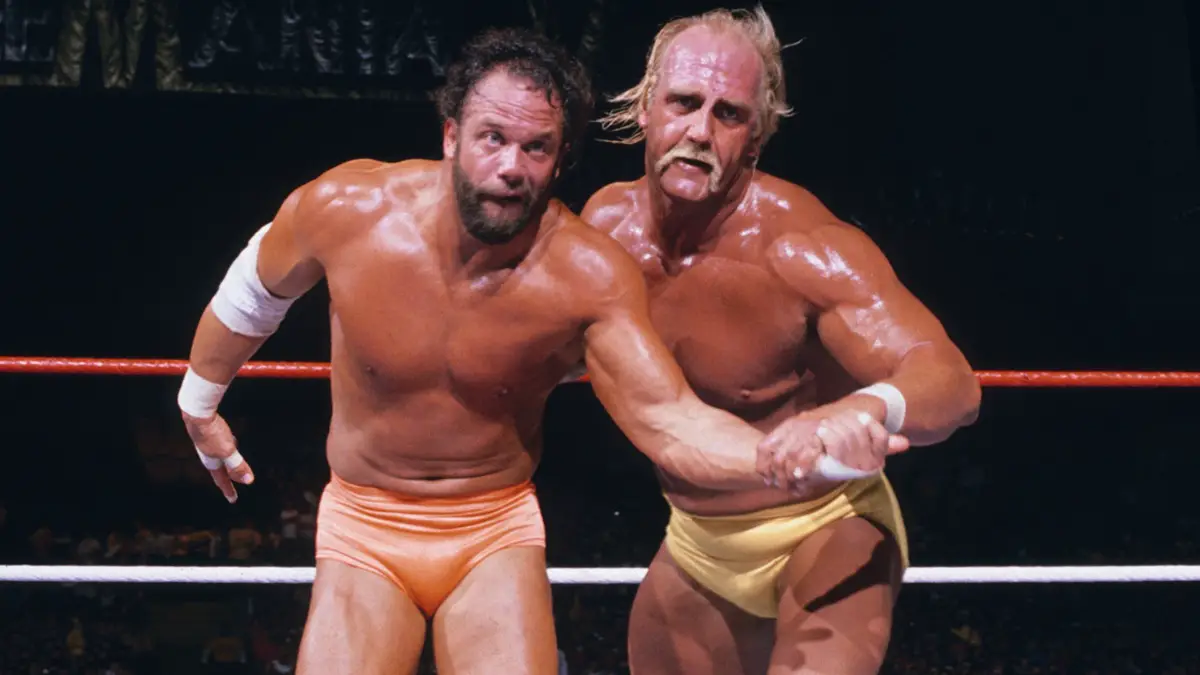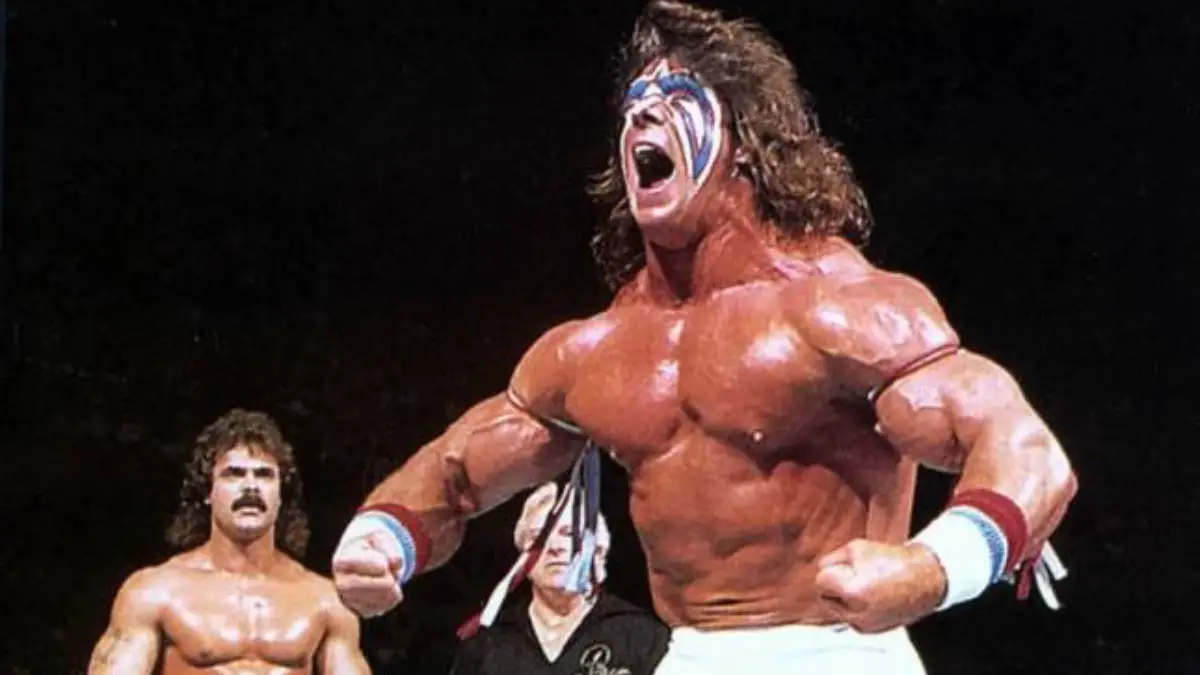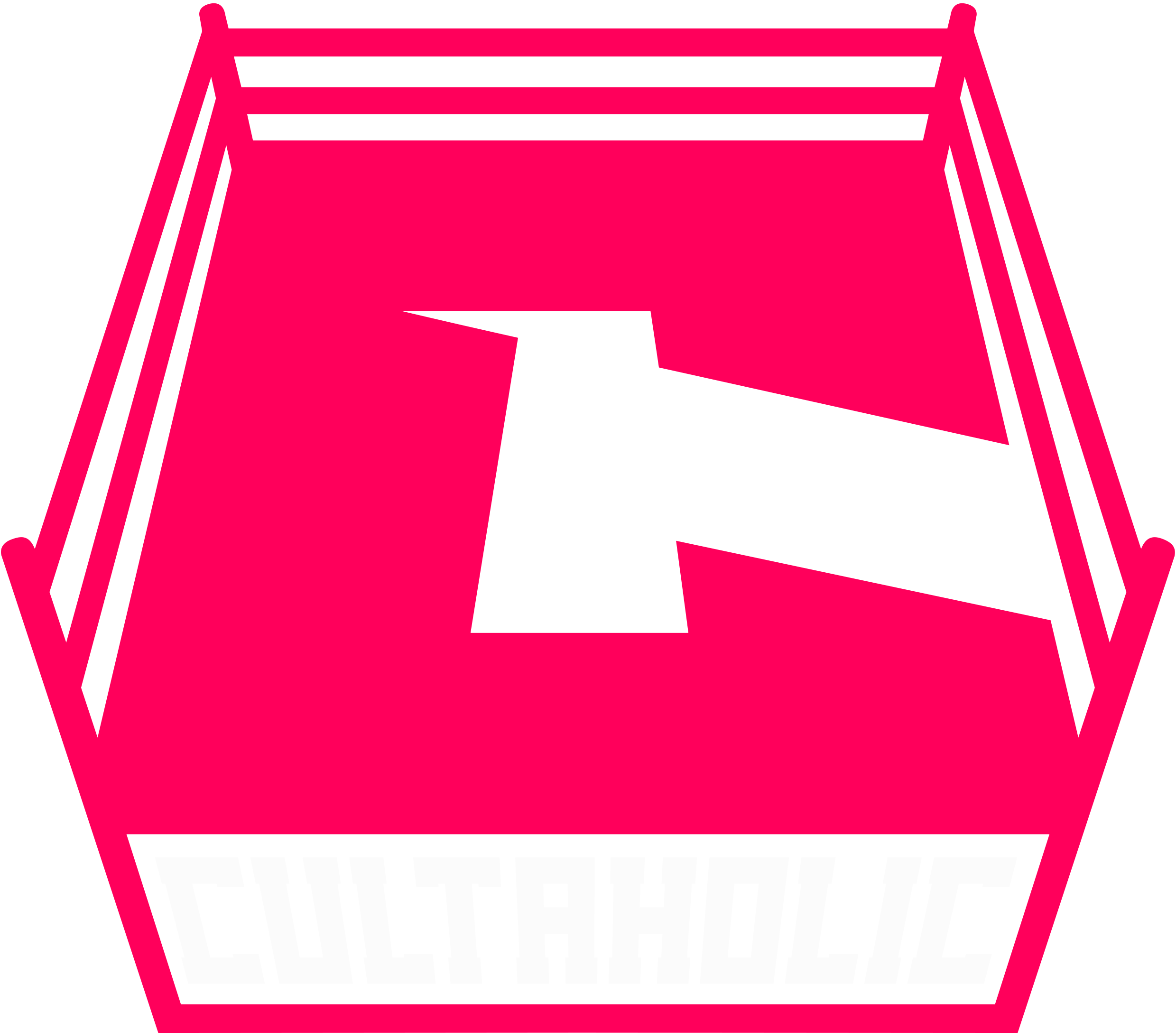True Story Of Vince McMahon's Incredible Act Of Promotional Pettiness
Vince McMahon's incredible Act Of Promotional Pettiness
On May 7, 1989, WCW held a pay-per-view called WrestleWar, which had the subtitle of "Music City Showdown", since it took place in Nashville. That "Music City Showdown" tagline would prove apropos, as there was some heated conflict within the confines of Music City itself. The most contentious battle didn't come between any two given wrestlers on WCW's roster, however. Rather, it came when WCW and WWE waged war that weekend inside Nashville city limits.
A year and a half earlier in November 1987, WCW, under the NWA banner, entered into the pay-per-view market with its fifth annual Starrcade. Vince McMahon saw WCW's attempt at peacefully doing business as an affront of some kind to his own empire, and felt that this micro-aggression should not stand. He then created the Survivor Series, scheduling it for the same night as Starrcade, and forcing cable providers to choose one over the other. To strengthen his standing, McMahon decreed that those providers who sided with WCW would not be getting WrestleMania 4 the following spring. The result was seven million American households were able to air Survivor Series, against just 300,000 for Starrcade.
The manoeuvring continued two months later when McMahon counter-programmed WCW's second pay-per-view, Bunkhouse Stampede, with the inaugural Royal Rumble on free TV, via the USA Network. Here, both companies actually fared well. With a national pay-per-view audience all to themselves, Bunkhouse Stampede did a buyrate 10 times that of Starrcade's paltry 20,000 buys, while the Royal Rumble became the highest-rated programme in USA Network's history.
For their part, WCW was willing to fire back. In March 1988, on the same night as WrestleMania 4, the first ever Clash of the Champions aired on TBS. Capped off by Sting's career-making performance in a 45-minute time limit draw with NWA Worlds Heavyweight Champion Ric Flair, the Clash was widely considered the better event of the two supercards, though WrestleMania still managed to pull in 485,000 buys, the highest for any WWE event yet.

In February 1989, WCW staged their fifth overall pay-per-view effort, the Chi-Town Rumble, in which Ricky Steamboat captured the NWA Worlds Heavyweight Title from Flair in the first battle of their acclaimed trilogy. The card aired on a Monday, and on that same night, WWE countered by ramping up their weekly Prime Time Wrestling telecast, making it a special three-hour edition, with appearances from both world champion Macho Man Randy Savage and WrestleMania 5 opponent Hulk Hogan.
In addition, two days before Chi-Town Rumble, WWE themselves held an event in Chicago, putting together a loaded-up house show featuring Hulk Hogan vs. The Big Boss Man inside a steel cage, and world champion Macho Man Randy Savage against Bad News Brown in a Street Fight. The untelevised WWE card drew 19,000 fans to the Rosemont Horizon, while WCW's pay-per-view brought 8,000 fans to the much smaller UIC Pavilion.
One year after inventing Clash of the Champions as a necessary weapon, WCW again tried fighting for space with WrestleMania, but got slaughtered this time around. The sixth-ever Clash of the Champions emanated from New Orleans' Superdome, but managed to draw only 5300 fans to the cavernous stadium for round two of Flair vs. Steamboat. Compounding that bitter pill was WrestleMania 5 raking in 767,000 buys, a WWE record that stood for close to 10 years. The Clash's rating, meanwhile, dipped significantly from the year before.
It was painfully obvious that WWE and WCW liked to counter-program against each other. With all the other viable territories dead, WWE only had one real rival left. And with or without Ted Turner's money propping them up, McMahon was still going for their throat.

Five weeks after WrestleMania 5 greatly overshadowed the Clash, WCW returned to pay-per-view with their latest endeavour, the aforementioned WrestleWar in Nashville, built on the foundation of the final chapter of Steamboat vs. Flair. It felt like your typical WCW show of the era with Sting, The Road Warriors, and Lex Luger in title bouts. The only thing on WrestleWar that really stood out from the norm was an in-show mini-concert from country music legends The Oak Ridge Boys.
The funny thing was WrestleWar wasn't originally intended to take place on May 7 - Ted Turner was going to have it oppose WrestleMania 5 on April 2, instead of the Clash of the Champions on free TV that we got. In February 1989, the major pay-per-view outlets approached Turner about running his own pay-per-view on April 2, the same night as WrestleMania, with the promise that they would carry it over McMahon's veritable pro wrestling Super Bowl.
Sounds almost too good to be true if you're WCW, and in fact it was - Vince McMahon was hardballing the providers, demanding a larger share of the revenue split for WrestleMania, which the cable providers were reluctant to agree to. The providers asked Turner to throw his hat into the ring with his own pay-per-view for the same date, not telling him that he was just a pawn being used to coerce McMahon into lowering his asking price. In the end, both wrestling companies had to swallow their pride - McMahon agreed to a smaller cut of the revenue in order for the providers to carry WrestleMania, and Turner had to accept that he'd been duped by the cable companies, solely as a means to their end.
So WCW's WrestleWar would instead run the following month on May 7, at Nashville's Municipal Auditorium. As for WWE, there weren't any pay-per-views on their docket until SummerSlam in August. Their next Saturday Night's Main Event was already taped, but wouldn't air until three weeks after WrestleWar. No cable TV specials were going to be invented in order to jostle with WCW's offering, so it seemed that Sunday, May 7, 1989 was going to belong to WCW and WCW alone.

The day may have belonged to them, but the weekend didn’t, and neither did the building. Following WrestleMania 5, WWE taped a few weeks' worth of television, before most of the roster took three weeks off from the road, save for a select handful that briefly toured Italy in April 1989. Upon resumption of the touring schedule, as per normal, the roster was divided up into three different troupes - an A-show headlined by WWE Champion Hulk Hogan, a B-show headed up by the Intercontinental Champion (in this case, Rick Rude), and a C-show in a smaller market, with generally a smaller selection of matches. This touring loop began two weeks before WCW's WrestleWar, and spanned much of the eastern half of the United States, with McMahon's deep roster able to cover lots of ground.
On Saturday, May 6, WWE ran three cities as per its norm - Indianapolis' Market Square Arena, Green Bay's Brown County Arena, and Nashville's Municipal Auditorium. The same Nashville Municipal Auditorium where WrestleWar would take place the following day, with a late afternoon start time. The big two promotions were running a weekend twin-bill in the same venue. They may have run Chicago close together in February, but that was two days apart, and two different buildings as well.
What could WWE really do to hurt WrestleWar? They could certainly take away from the walk-up ticket sales - a fan who has enough money to attend only one show could be more tempted by the WWE line-up, choosing them over WCW. Aside from that, it's not like they're putting up their own pay-per-view against WrestleWar, right? How much more sabotage could WWE really attempt?
Maybe it's unfair to call it sabotage, but what WWE ended up doing certainly wasn’t promotional niceties. WWE's A and B-shows the day before on Friday, May 5 took place in St. Louis and Washington DC. The DC show featured Bret Hart vs. Mr. Perfect, Rick Martel vs. Tito Santana, Demolition defending the Tag Team belts against The Twin Towers, and Ultimate Warrior challenging the man who beat him for the IC title, Rick Rude. Since Hogan didn't appear at either event, this Washington card was probably the A-show.
Over in St. Louis, WWE put on a reasonable card featuring Macho Man Randy Savage against Brutus Beefcake and Ted DiBiase vs. Jake Roberts, as the night's two major bouts, with an objectively average undercard. The wrestlers from that show would work in Indianapolis on Saturday, while the talent on the previously-mentioned DC card (Warrior vs. Rude, Bret vs. Perfect, etc) were headed to Saturday's Nashville event, at the site of WrestleWar.
To try and counter the WWE's Saturday night card in the same building, WCW put together a special autograph signing and t-shirt giveaway at the Hickory Hollow Mall in a Nashville suburb, which took place at the same time as the WWE house show. The event was attended by several thousand people, and was considered a rousing success.

But WWE, they had a counter to the counter and they were determined to win the weekend. In addition to the already impressive lineup that was booked for Nashville, WWE chartered a flight for the four top wrestlers on the Indianapolis card; Savage, Beefcake, Roberts, and DiBiase. They were being flown to Nashville for the Saturday night card, and had their matches riveted on to the end of the advertised event. All of a sudden, WWE was tempting the local crowd with two late additions in the form of Randy Savage vs. Brutus Beefcake, and Jake Roberts vs. Ted DiBiase, on top of Warrior vs. Rude, Demolition vs. the Twin Towers, Santana vs. Martel, and more. Bear in mind, those four stars worked twice that day - as early as possible on the card in Indy, then chartered into Nashville for their second act.
With this pretty impressive cache of talent on hand for the Nashville card, WWE had one general order for the night - stall. It just so happens that a young Dave Meltzer was in Nashville that weekend to attend WrestleWar, and also went to the WWE show the previous night. His report of the show revealed the lengths WWE went to stretch out their own event, giving WCW far less time to set up for the following afternoon's pay-per-view.
Bret Hart and Mr. Perfect fought to a time-limit draw in the evening's third match, which is admittedly what they had been doing at house shows around the circuit at the time. Immediately afterward, Hillbilly Jim defeated the Honky Tonk Man via disqualification in a match where both men didn't make contact for the first six minutes.
The IC Title bout pitting Rude against Warrior saw more in the way of slowed-down wrestling, complete with extended bear hugs and such. The clock crept past 10:30 PM when preliminary talents Jim Powers and Iron Mike Sharpe were sent out to kill time for a bit, reportedly because they were still waiting for the four sudden headliners to get in from Indianapolis.
After Demolition defeated the Twin Towers in what would've ostensibly been the main event, out came the two bonus matches. It was beyond 11 PM when Savage and Beefcake took to the ring, the two wrestling in their second match of the day. Savage won via chicanery from Sensational Sherri, paving the way for the main event.
In a match that Meltzer referred to as "virtually all restholds", Roberts cradled DiBiase for the win, fulfilling each man's double-duty and ending the show, sometimes well after 11:30 PM local time. So ended what was a rather elaborate bit of passive-aggressive pettiness on WWE's part.

The payoff to all of that silliness? Not a whole lot. WrestleWar did a comparable buyrate to the pay-per-views that surrounded it. It was also less attended than the WWE house show, which had to be a little humbling. WWE drew close to 8000 fans for a building that seated around 8500. For WCW, however, they only drew 5200 fans to the Auditorium. They were already going to have less available capacity, due to seats being blocked off for the in-show Oak Ridge Boys concert, but they still wound up with 65 percent of the audience WWE pulled in, for a pay-per-view no less. It is pretty hard to place any blame on attendance to WWE’s meddling - in 1989, they were the more popular promotion in droves, and Turner had to settle for second place for a long time to come.
There didn't seem to be much in the way of similar shenanigans in the coming years - WWE and WCW mostly put on their ensuing pay-per-views without interference or hindrance from the opposition, no Clash of the Champions or dual running of the cities out of spite.
Spite doesn't rest forever in pro wrestling, though. The Flair/world title fiasco in WWE, the big-money signings of Vince's biggest stars by WCW, and, of course, The Monday Night Wars were all to come.
Until those future days came to pass, this was a hearty slice of primordial spite, proving that you didn't need Eric Bischoff, duelling Monday night broadcasts, and an industrial paradigm shift for WWE and WCW to take up arms against each other, no matter how childishly.
